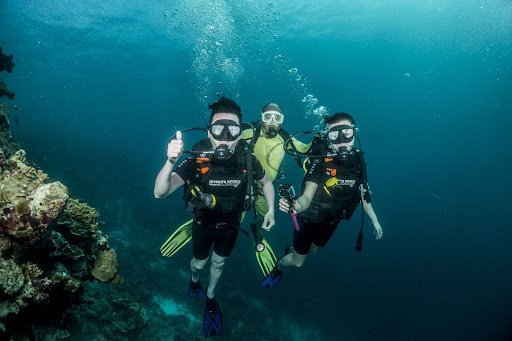The Maldives is a dream destination not only for honeymooners and beach lovers but also for divers from around the globe. Renowned for its crystal-clear waters, vibrant coral reefs, and extraordinary marine biodiversity, scuba diving in Maldives offers a world-class underwater adventure you won’t find anywhere else.
Whether you’re a seasoned diver or a beginner eager to explore the depths, the Maldives has something magical in store. From exhilarating drift dives and manta ray encounters to swimming with whale sharks and exploring submerged wrecks, diving in this island nation is both diverse and accessible.
Why the Maldives Is a World-Class Diving Destination
Exceptional Water Clarity
The Maldives boasts visibility ranging from 20 to 40 meters, offering divers a panoramic view of underwater life. This clarity, combined with the warm waters (26–30°C year-round), creates the perfect conditions for extended and immersive dive sessions.
Diverse Marine Life
The atolls and channels are home to:
- Over 2,000 species of fish
- More than 200 species of coral
- Whale sharks and manta rays
- Reef sharks, turtles, moray eels
- Macro critters like nudibranchs and ghost pipefish
Whether you’re hoping to spot big pelagics or rare nudibranchs, you’ll be amazed by the biodiversity in every corner of the Maldivian seas.
Best Time for Scuba Diving in Maldives
While diving is possible year-round, the Maldives has two distinct diving seasons:
Northeast Monsoon (December to May)
- Calm seas and better visibility
- Best for whale sharks and manta rays
- Ideal time for beginners and photographers
Southwest Monsoon (June to November)
- More plankton = more mantas and whale sharks
- Reduced visibility but busier marine life
- Great for advanced divers due to stronger currents
Top Diving Sites in Maldives
1. Maaya Thila (North Ari Atoll)
A protected marine area teeming with reef sharks, turtles, batfish, and barracudas. Known for night diving and dramatic overhangs.
2. Fotteyo Kandu (Vaavu Atoll)
One of the most colorful dive sites with tunnels, overhangs, and steep walls. Currents bring in pelagic species and large schools of fish.
3. Kandooma Thila (South Male Atoll)
A thrilling drift dive site with strong currents, gray reef sharks, and eagle rays. Best suited for experienced divers.
4. Banana Reef (North Male Atoll)
Perfect for beginners, this site features caves, soft corals, and an abundance of fish life in a shallow, easy-to-navigate environment.
5. Hanifaru Bay (Baa Atoll)
A UNESCO Biosphere Reserve and one of the best places to snorkel with hundreds of manta rays during the plankton-rich season.
Liveaboard vs Resort Diving: What’s Best?
Liveaboard Diving
If you want to explore multiple dive sites across different atolls, a liveaboard is your best bet. These luxury boats are equipped with full dive centers, onboard instructors, and customized dive itineraries that maximize your time underwater.
Liveaboards are ideal for serious divers who want multiple dives per day, access to remote dive spots, and a floating resort experience.
Resort Diving
Resorts often have house reefs and offer daily boat dives. This option is great for couples or families looking to mix diving with relaxation. Many resorts also offer PADI and SSI certification programs.
What to Expect During a Dive
A typical diving day in the Maldives looks like this:
- Briefing Session: Dive guides provide safety instructions, dive profiles, and marine life info.
- Boat Ride: Dhonis (Maldivian dive boats) take you to the dive site.
- Gear Up & Dive: Most dives are drift dives, so you’ll enter the water from the boat and be picked up downstream.
- Post-Dive Snack: Enjoy tropical fruits and tea between dives on board.
Night dives, wreck dives, and deep dives are also available depending on your certification and experience level.
Scuba Diving for Beginners
Never dived before? No problem. The Maldives is a great place to get certified. Most resorts and liveaboards offer:
- PADI Open Water Diver Courses
- Discover Scuba Diving (no certification required)
- Advanced and specialty courses (e.g., underwater photography, night diving)
Calm lagoons and shallow reefs provide safe environments for beginners to learn and gain confidence.
Safety and Environmental Responsibility
Diving Safety
- Always dive with a certified instructor or guide
- Stay within your certification limits
- Use a dive computer and signal devices
- Maintain good buoyancy to avoid damaging the reef
Eco-Friendly Practices
- Never touch or chase marine life
- Use reef-safe sunscreen
- Don’t collect coral or shells
- Support dive operators involved in conservation
The Maldives has a strong commitment to marine preservation. Many dive centers support coral restoration projects, whale shark tracking, and reef cleanups.
What to Pack for a Scuba Diving Trip
- Certification cards/logbook
- Mask, snorkel, fins (if you prefer your own)
- Dive computer and underwater camera
- Rash guard or shorty wetsuit
- Dry bag and reef-safe sunscreen
Local Culture and Post-Dive Activities
Beyond diving, Maldives offers:
- Island hopping
- Dolphin watching
- Sunset cruises
- Spa treatments
- Traditional Maldivian cuisine
- Cultural tours of fishing villages
The rich hospitality and welcoming culture make your diving vacation even more enjoyable.
Why the Maldives Should Be Your Next Dive Destination
The Maldives offers one of the most immersive diving experiences in the world — pristine reefs, massive pelagics, expert guides, and top-notch dive infrastructure. Whether you’re coming for certification, relaxation, or adventure, scuba diving here will exceed your expectations.
For a truly seamless and luxurious diving experience, book your next dive with Spirit. Spirit Liveaboards provides expertly curated dive itineraries, premium accommodations, and unmatched access to the Maldives’ best dive sites — all with a strong commitment to safety and marine conservation.







